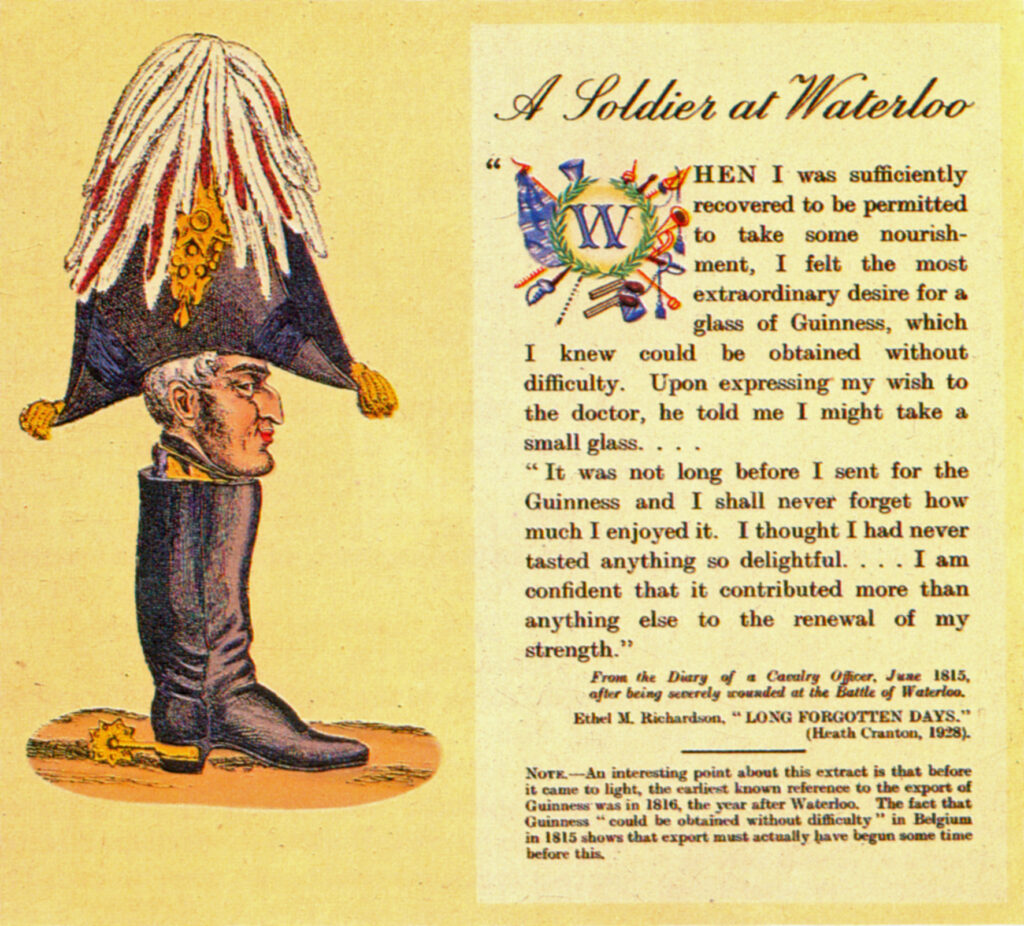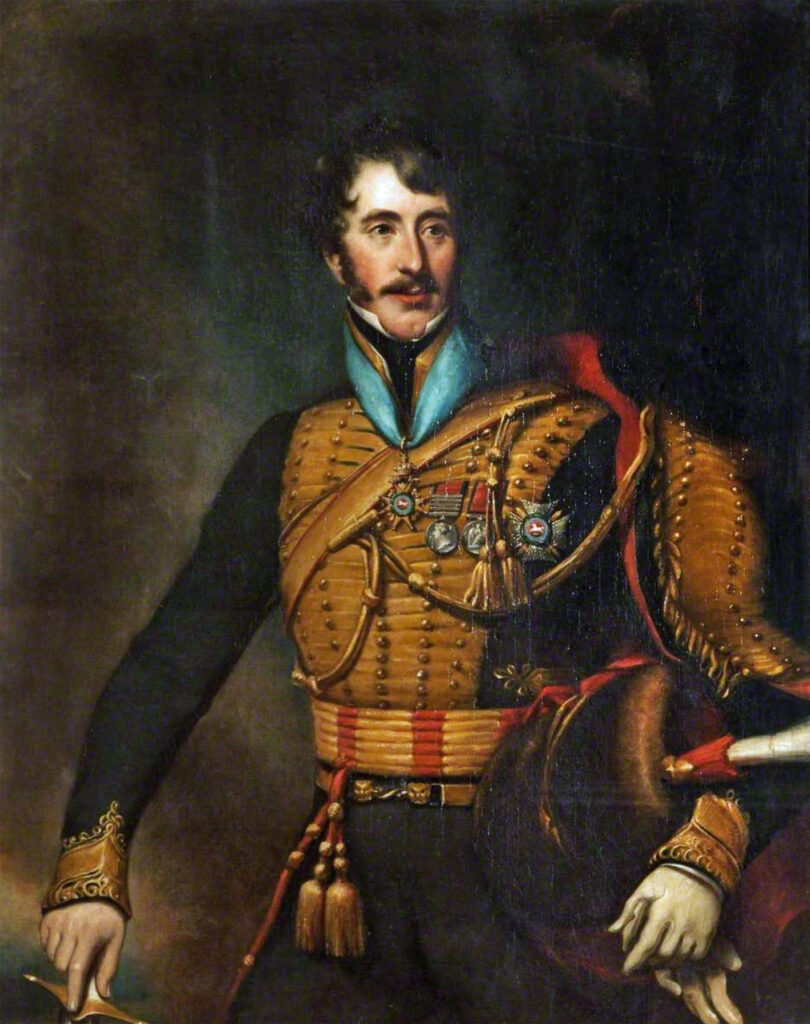On Sunday June 18 1815 at around 6pm in the evening, at the height of the Battle of Waterloo, ten miles south of Brussels, a 33-year-old captain in the 7th (Queen’s Own) Regiment of Hussars named William Verner, born in County Armagh, Northern Ireland, was hit in the head by a French bullet — one of 47,000 casualties that day.
Our interest in Verner, of all those men involved in what one of the most pivotal battles in world history, 207 years ago today, is that his story gives us the trivial – but still, in terms of beer history, if not world history, significant – first mention of Guinness being available in continental Europe.

Verner and his regiment, part of the 25,000 British troops and 43,000 allies soldiers under the command of the Duke of Wellington, had several skirmishes with the enemy during the battle before they came under fire in the early evening from French infantry sheltering in trees near to where they were stationed. The officers were maneuvering their horses backwards and forwards, to try to stop the infantry taking deliberate aim at them, and Verney had just turned his horse when he was hit by a French bullet on the right side of his head.
It struck the metal links of his hussar helmet’s chinstrap with a loud clang, which saved his life, but stunned him, leaving him bleeding and badly enough injured that he departed the field for the nearby village of Waterloo, where a surgeon sent him to Brussels for treatment. His wound dressed, he found a billet in Anderlecht, then “about a mile out of Brussels”. There, within a few days, he became dangerously ill with a fever, writing later: “I was nearly a month in bed, reduced almost to a skeleton, and when I attempted to get up, unable to stand.
“By degrees my strength returned but was not fully restored for many months. A curious circumstance occurred, which I have often thought of since. When I was sufficiently recovered to be permitted to take some nourishment, I felt the most extraordinary desire for a glass of Guiness’s [sic] porter, which I knew could be obtained without difficulty. Upon expressing my wish to the doctor, he told me I might take half a tumbler or a small glass, but no more, as if I exceeded it it might prove very injurious. It was not long before I sent for the porter, and I shall never forget how much I enjoyed it. I thought I had never tasted anything so delightful. It was only for a very short time I was satisfied with prescribed quantities; the dose soon became increased, and I am confident that it contributed more than anything else to the renewal of my strength.”
Verner’s story, lightly tweaked, was used by Guinness in its advertising some 120 years later. Guinness continued to be available in Belgium, with adverts for “première qualite de Bière Anglais [sic], dite Porter, de la brasserie de Guinness’s” in newspapers in Ghent in 1838, and Guinness’s stout, alongside ”Lard Anglais” on sale in Brussels in 1862.
Verner’s father James was an MP in the Irish parliament, and had a house in Dawson Street, Dublin from 1794, which is presumably where William became familiar with Guinness‘s porter. He was promoted to major after Waterloo, and eventually rose to be a lieutenant-colonel in the 7th Hussars. He was later an MP for County Armagh for 34 years, and created a baronet in 1846, dying in 1868, aged 86, doubtless after many more pints of Guinness.



More interesting research, Martyn.
Forty years ago, when I first started to visit Belgium, British beers such as Bass, Whitbread and Guinness (an Irish beer usually London-brewed I think for the Belgian market) were seen in many bars and cafes, together with Belgian brands of English beer such as John Martin’s Pale Ale (brewed by Courage, but sold as Bulldog in the UK market).
I may be wrong but it does seem to me that British beers are now much less popular than they were, and that mass-produced brands such as Leffe are much more popular, than they used to be.
It depends on how and where you look, Rod.
What I suddenly noticed a couple of years ago, drinking a Tripel LeFort on the market in Ieper, was that almost all references to Stella-Artois on bars and cafés had disappeared, and were replaced by much more local beers, like LeFort, Omer, Cornet, yeah, well almost every terrace seems to have his own different beer brands to display.
When I was little (1972-1980), every café had “Stella-Artois” on top of it, and not much else. If you saw “Duvel”, then it was on restaurant.
I actually don’t know much places where you can find Leffe Blond, e.g. I think you will find it more in a restaurant than in a café. Most cafés have the selection of a couple of trappists (bonus points for Orval), probably a selection from Moortgat, and sometimes a couple of very local beers. One sees less gueuze and lambic these days.
It must be lucrative to have many beers on tap and in bottle. I live in small village, with appr. 5000 residents. We have one café (from a whole lot of other drink and food businesses) which serves all trappist beers, and then beers from breweries Het Anker and De Halve Maan. Probably 40 types of bottled beer, and then also different kegs.
Like I said about the restaurants, they seem to be less inclined to provide a nice beer selection than bistros and cafés and other small eating businesses, and have mostly a mediocre AbInbev selection.
Fascinating micro insight
[…] Conversely – at least in the heroic outcome department – Martin himself shared another bit of research no doubt uncovered in the preparation of his upcoming book on stout with the tale of how Guinness administered under medical care got one particular gent out of a rather challenging personal situation: […]